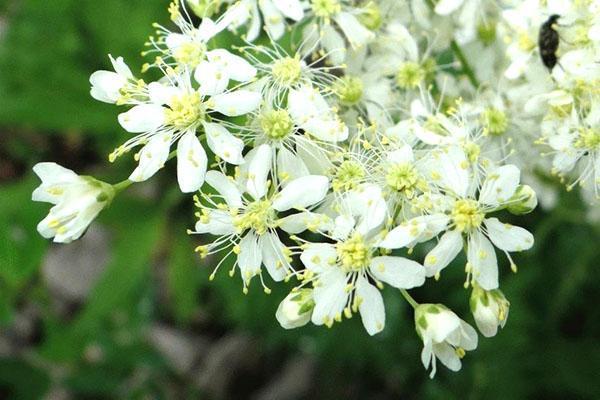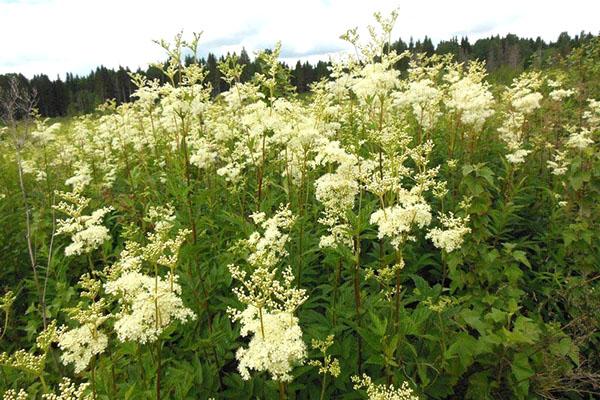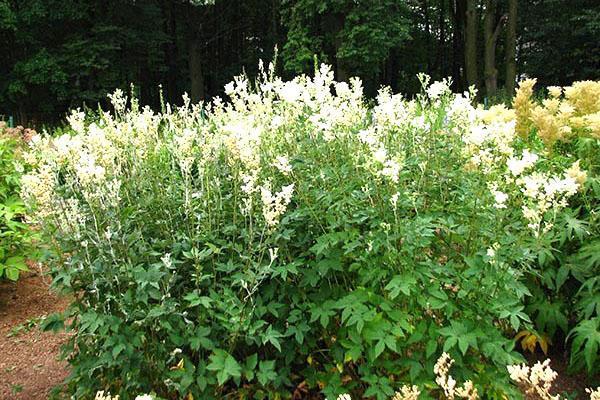We grow at home of unusual beauty meadowsweet
 Meadowsweet (meadowsweet) is a perennial herb that belongs to the Pink family. In nature, it grows in a temperate climate, meadowsweet can be found in meadows, river banks or lakes. It is harvested during the flowering period, dried and used to prepare medicinal decoctions and infusions. The meadowsweet plant can also be grown at home - it has a long and abundant flowering.
Meadowsweet (meadowsweet) is a perennial herb that belongs to the Pink family. In nature, it grows in a temperate climate, meadowsweet can be found in meadows, river banks or lakes. It is harvested during the flowering period, dried and used to prepare medicinal decoctions and infusions. The meadowsweet plant can also be grown at home - it has a long and abundant flowering.
Description of the plant

Types of meadowsweet and their use
Meadowsweet is grown as an ornamental plant to decorate a garden or flower beds. For medicinal purposes, only 4 varieties are suitable: visleaf, six-leaved, Kamchatka and palm-like. The varieties of this herb are easily distinguished by the shape of the leaves, the size and color of the flowers.
Six-petalled meadowsweet (common)
 Common meadowsweet is one of the most useful species. An adult plant does not exceed 60-80 cm in height, while it has a developed rhizome with tubers. It can be found in well-lit areas: in meadows and roadsides, and grass can also grow on forest edges. Flowers form paniculate inflorescences with a white tint and a pronounced odor.
Common meadowsweet is one of the most useful species. An adult plant does not exceed 60-80 cm in height, while it has a developed rhizome with tubers. It can be found in well-lit areas: in meadows and roadsides, and grass can also grow on forest edges. Flowers form paniculate inflorescences with a white tint and a pronounced odor.
This type of meadowsweet is used for medicinal purposes. From its root, leaves and dried flowers, infusions and decoctions are prepared. Such funds help with various pathologies:
- chronic inflammatory diseases of the gastrointestinal tract;
- diseases of the kidneys and urinary system (meadowsweet has a diuretic effect);
- arthritis, arthrosis, joint pain of various origins;
- decoction of rhizomes - for washing wounds, from bites of poisonous animals and insects.
Common meadowsweet is a rather rare species. However, it has the most pronounced medicinal properties and has found application, including in official medicine.
Meadowsweet
 Vase-leaved meadowsweet is the most common variety. It is a tall herbaceous plant that can grow up to 150 cm. Its natural habitat is forest thickets, the shores of swamps and reservoirs. This type is also used in traditional medicine and is included in official preparations. It has a pronounced anticonvulsant, antibacterial and anti-inflammatory effect, can be used for a number of diseases:
Vase-leaved meadowsweet is the most common variety. It is a tall herbaceous plant that can grow up to 150 cm. Its natural habitat is forest thickets, the shores of swamps and reservoirs. This type is also used in traditional medicine and is included in official preparations. It has a pronounced anticonvulsant, antibacterial and anti-inflammatory effect, can be used for a number of diseases:
- disorders of the heart and blood vessels, especially hypertension;
- disorders of the nervous system;
- dermatological problems, including burns, ulcers, diaper rash and dermatitis of any origin;
- any inflammatory pathologies of internal organs;
- colds.
From the photo, the meadowsweet is easy to distinguish from the ordinary one. This plant is larger, has a straight, strong stem and feathery leaves. The inflorescences are white, but they are larger and more lush.
Labaznik Elegance
 The elegans variety of meadowsweet is distinguished by bright decorative inflorescences painted in a purple shade.These are bushes of medium height (50-100 cm) with original finger-like leaves. They grow quickly, so they can be used to create flower arrays or hedge. Meadowsweet can also be added to bouquets, but more often it is planted in open ground.
The elegans variety of meadowsweet is distinguished by bright decorative inflorescences painted in a purple shade.These are bushes of medium height (50-100 cm) with original finger-like leaves. They grow quickly, so they can be used to create flower arrays or hedge. Meadowsweet can also be added to bouquets, but more often it is planted in open ground.
This variety is popular for home breeding for several reasons:
- unpretentiousness to keeping conditions - plants tolerate temperature changes well and adapt to weather conditions;
- flowering duration - the period lasts throughout the summer;
- the ability to endure winter outdoors without shelter.
Photos of the elegans meadowsweet will be different. Shades of flowers vary from pale pink to bright crimson, the height of the plant also differs. It depends not only on the growing conditions, but also on the breeding method - individuals grown from seeds are smaller and weaker.
Plena grade
 Plain's meadowsweet are low ornamental plants that can reach up to 40 cm. They are popular in landscape design due to their spectacular appearance and ease of maintenance. This variety adapts well both in the shade of trees or taller bushes and in open areas. It is popular for decorating flower beds, creating lush flower arrays and low decorative borders.
Plain's meadowsweet are low ornamental plants that can reach up to 40 cm. They are popular in landscape design due to their spectacular appearance and ease of maintenance. This variety adapts well both in the shade of trees or taller bushes and in open areas. It is popular for decorating flower beds, creating lush flower arrays and low decorative borders.
In late May or early June, peduncles up to 15 cm long appear on each bush. On them are lush white inflorescences, which consist of flowers about 1 cm in diameter. The flowering period lasts at least a month.
Red Meadowsweet Venusta
 Meadowsweet Venusta is one of the largest varieties. Adult bushes can reach up to 2.5 m in height, are distinguished by a particularly strong stem and developed rhizome. The flowers are collected in lush inflorescences, becoming colored in various shades of pink. Meadowsweet begins to bloom in early summer, but retains its decorative appearance until the first frost due to the unusual shape of the leaves. They are large, with five or seven lobes.
Meadowsweet Venusta is one of the largest varieties. Adult bushes can reach up to 2.5 m in height, are distinguished by a particularly strong stem and developed rhizome. The flowers are collected in lush inflorescences, becoming colored in various shades of pink. Meadowsweet begins to bloom in early summer, but retains its decorative appearance until the first frost due to the unusual shape of the leaves. They are large, with five or seven lobes.
Red meadowsweet is a wild plant. It can be found everywhere: in the forest-steppe zone, on the banks of rivers and reservoirs. In landscape design, these flowers are popular when creating hedges, landscaping adjacent areas and recreation areas.
Shrubs can be planted in open areas as well as in the shade of trees and in mixed plantings with larger plants. However, severe darkening can lead to loss of bloom.
Growing at home
 Meadowsweet can be found in natural conditions. For medicinal purposes, it is harvested during the flowering period, and it is also sold in pharmacies in dried crushed form. Ornamental varieties are more often grown at home. They quickly take root, do not require daily care and shelter in the cold season.
Meadowsweet can be found in natural conditions. For medicinal purposes, it is harvested during the flowering period, and it is also sold in pharmacies in dried crushed form. Ornamental varieties are more often grown at home. They quickly take root, do not require daily care and shelter in the cold season.
 There are two ways of breeding meadowsweet: by seeds and by division. The first method is simpler, it is enough to collect the seeds and plant them in late autumn. They need stratification (they must endure the winter temperature drop), so spring planting is not suitable for them. A more reliable way is grafting. Areas of rhizome or shoots with 2-3 vegetative buds are suitable for planting. It is enough to simply place them in the ground at a distance of 40-50 cm from each other. The procedure is carried out in September or April.
There are two ways of breeding meadowsweet: by seeds and by division. The first method is simpler, it is enough to collect the seeds and plant them in late autumn. They need stratification (they must endure the winter temperature drop), so spring planting is not suitable for them. A more reliable way is grafting. Areas of rhizome or shoots with 2-3 vegetative buds are suitable for planting. It is enough to simply place them in the ground at a distance of 40-50 cm from each other. The procedure is carried out in September or April.
 Meadowsweet is an unpretentious plant. It can thrive and bloom in shade or open sun, and even tolerate short periods of drought. However, there are several rules that will help achieve the fastest possible growth and lush flowering of bushes:
Meadowsweet is an unpretentious plant. It can thrive and bloom in shade or open sun, and even tolerate short periods of drought. However, there are several rules that will help achieve the fastest possible growth and lush flowering of bushes:
- maintain constant soil moisture in the flower bed;
- periodically loosen the ground;
- weeds are removed for decorative purposes - meadowsweet quickly displaces foreign crops;
- bushes can be transplanted at least once every 5 years;
- neutral or slightly acidic soils are best suited.
The meadowsweet has one feature - its rhizome grows upward.If you do not periodically add new soil under the bush, it can be exposed to the sun.
 Photos of a meadowsweet, planting and caring for which will not be difficult even for beginners, will be different. Due to the wide variety of varieties, you can choose lower or higher varieties with different colors of flowers. These plants are more suitable for outdoor cultivation and landscaping, but they can also be cut. In bouquets, they are in harmony with other flowers, complement pastel colors and dilute brighter shades.
Photos of a meadowsweet, planting and caring for which will not be difficult even for beginners, will be different. Due to the wide variety of varieties, you can choose lower or higher varieties with different colors of flowers. These plants are more suitable for outdoor cultivation and landscaping, but they can also be cut. In bouquets, they are in harmony with other flowers, complement pastel colors and dilute brighter shades.
 Meadowsweet (meadowsweet) is more than 15 varieties of wild-growing herbs. They are used for decorative and medicinal purposes, collected in natural conditions or grown at home. Plants look spectacular thanks to large bright inflorescences and leaves of an unusual shape. This is a non-standard solution for decorating flower beds, lawns or prefabricated bouquets.
Meadowsweet (meadowsweet) is more than 15 varieties of wild-growing herbs. They are used for decorative and medicinal purposes, collected in natural conditions or grown at home. Plants look spectacular thanks to large bright inflorescences and leaves of an unusual shape. This is a non-standard solution for decorating flower beds, lawns or prefabricated bouquets.